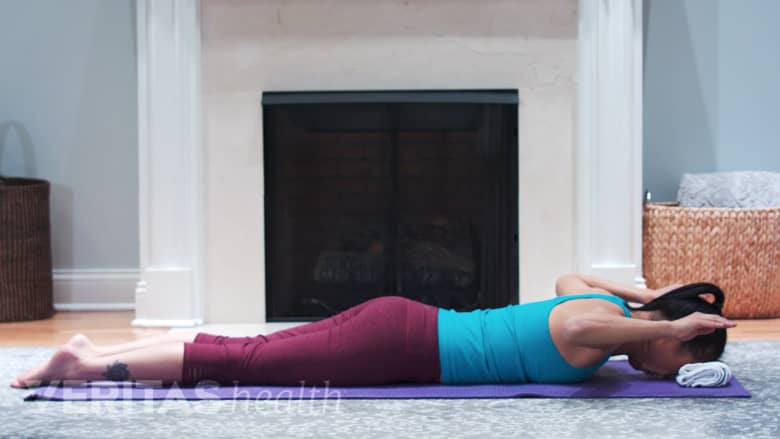Stretching and exercising the neck help it to maintain mobility and better support the head. A strong and flexible neck functions better and is less likely to become painful, which may also reduce the risk of associated dizziness.
In This Article:
- Home Remedies for Neck Pain and Dizziness
- Stretches and Exercises for Neck Pain and Dizziness
- Video: Home Remedies for Neck Pain
Gentle Stretches for Neck Pain and Dizziness
Stretching the neck can help reduce muscle tension and increase range of motion. Some gentle stretches to try include:
- Neck Flexion and Extension. Gently tilt the head forward with the chin going down as far as it can comfortably go. Then tilt the head all the way backward, looking up toward the ceiling.
- Lateral Neck Flexion. Gradually bend the head to the left, bringing the left ear toward the left shoulder. Then repeat on the right side.
- Neck Rotation. Slowly turn the head to the left, then to the right.
See Neck Stretches
- Levator Scapulae Stretch. Raise the right elbow above the shoulder and rest it on a door jamb. Keeping the shoulders still, turn the head to the left and tilt the chin down toward the collarbone to stretch the back of the neck. Hold for 30 to 60 seconds, then repeat on the other side.
Strengthening Exercises for Neck Pain and Dizziness
Some studies have suggested that a weakened neck and/or forward head posture may increase the risk for neck pain and dizziness.1Liu X-M, Pan F-M, Yong Z-Y et al. Does the longus colli have an effect on cervical vertigo? Medicine (Baltimore). 2017; 96(12):e6365. doi: 10.1097/MD.0000000000006365,2Fortner MO, Oakley PA, Harrison DE. Alleviation of posttraumatic dizziness by restoration of the cervical lordosis: a CBP® case study with a one year follow-up. J Phys Ther Sci. 2018; 30(5):730-3. doi: 10.1589/jpts.30.730. The following exercises can help strengthen the muscles to maintain better posture throughout the day, keeping the shoulders back and the ears directly above the shoulders:
Chin Tuck
The chin tuck exercise strengthens the neck muscles.
Sit upright and look straight ahead with the ears directly above the shoulders. Pull the chin and head straight back while keeping the eyes focused straight ahead. When a good stretch is felt at the top of the neck and base of the head, hold it for 5 seconds. Repeat up to 10 times. This exercise can also be performed while standing if comfortable.
See Easy Chin Tucks for Neck Pain
Back Burn

Backburn exercise helps to strengthen the neck muscles and open up tight chest muscles.
Stand up straight with the back and head flat against a wall, feet shoulder width apart. Hold the arms straight out to the sides at shoulder height with the back of the hands against the wall. Keeping the arms and hands against the wall, slowly slide the hands up above the head and then slowly back down. Try to repeat 10 times.
See Neck Strengthening Exercises
Prone Cobra

The prone cobra exercise strengthens the neck and shoulder muscles.
While lying face down on the floor or a yoga mat, place the forehead on a pillow or rolled-up towel. Raise your head, chest, and arms while keeping the elbows out to the side and squeezing the shoulder blades together. Keep the forehead at least an inch off the ground with the eyes looking downward (rather than looking up and overarching the neck). Hold for 10 seconds if possible, then rest. Try to do 10 repetitions.
Tips for Exercising with Neck Pain and Dizziness
It is not advised to exercise while dizzy unless under the guidance and supervision of a medical professional. If a particular exercise or stretch increases neck pain or dizziness, it should be stopped.
See Physical Therapy for Neck Pain Relief
For some cases of recurrent dizziness, a doctor may prescribe vestibular rehabilitation therapy (VRT). VRT exercises can vary widely and depend on the specific diagnosis. Typically, VRT involves exercises that are focused on eye movements, posture training, and improving balance. VRT commonly induces some symptoms of dizziness as part of the process, so it is best performed under the guidance of a trained medical professional.3Home-based exercise. Vestibular Disorders Association (VeDA) website. https://vestibular.org/understanding-vestibular-disorders/treatment/vestibular-home-therapy. Accessed February 8, 2019.
- 1 Liu X-M, Pan F-M, Yong Z-Y et al. Does the longus colli have an effect on cervical vertigo? Medicine (Baltimore). 2017; 96(12):e6365. doi: 10.1097/MD.0000000000006365
- 2 Fortner MO, Oakley PA, Harrison DE. Alleviation of posttraumatic dizziness by restoration of the cervical lordosis: a CBP® case study with a one year follow-up. J Phys Ther Sci. 2018; 30(5):730-3. doi: 10.1589/jpts.30.730.
- 3 Home-based exercise. Vestibular Disorders Association (VeDA) website. https://vestibular.org/understanding-vestibular-disorders/treatment/vestibular-home-therapy. Accessed February 8, 2019.

